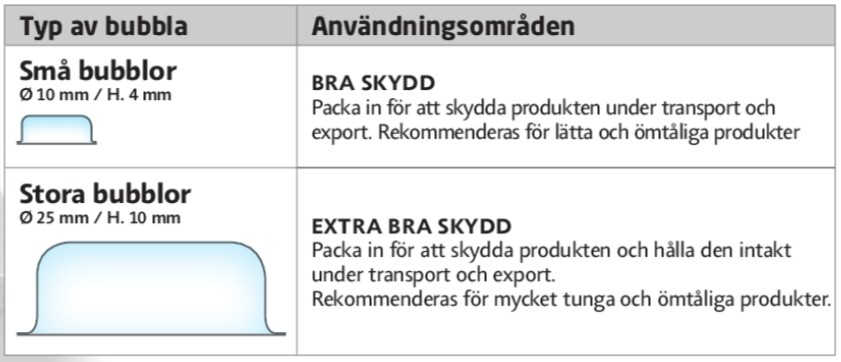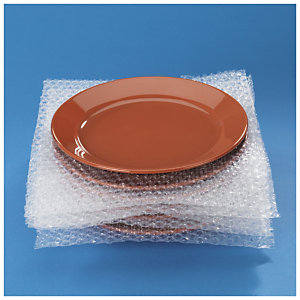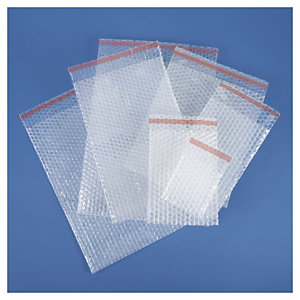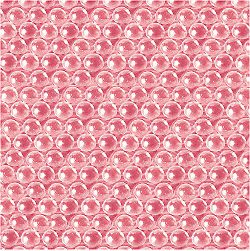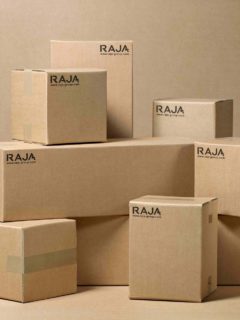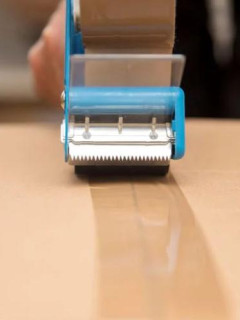Bubble wrap or foam film – which filling material is best for your products? The materials are similar in many ways but also have their distinctive properties that can help you make your choice.
Bubble wrap – versatile and popular
Bubble wrap is made up of hundreds of tiny air pockets encased in a soft layer of polyethylene. It is this structure that gives the material its cushioning and protective properties. It’s no wonder that bubble wrap is one of the most popular packaging materials for RAJA customers. It is lightweight, affordable and provides really good and versatile protection.
Bubble wrap is available in different grades so you can choose a material depending on how heavy, sharp or fragile the item you want to protect is. The most common and economical is to use bubble wrap with small bubbles on a roll that can easily be cut to the length you want. Choose our eco-friendly bubble wrap, which is made from 80% recycled material. If your products need more protection, we also have bubble wrap with large bubbles.
Save time with dispensers, perforated sheets or pre-made bags
Want to avoid the hassle of measuring and cutting pieces to the right size? Choose perforated rolls, and you can tear off finished pieces of the same size quickly and neatly instead. Perfect if you’re packing lots of similar-sized items. Bubble wrap in a dispenser box makes the process even easier. If you’re sending small items, our pre-made bubble bags may be perfect for you. Sending electronics? Then you should look at anti-static bubble wrap, which is distinguished in our range by its pink colour. This material disperses the electrostatic charge and thus protects your products from static electricity.
Risk of marks on fragile products
Be careful if you want to use bubble wrap to protect products with delicate surfaces. The pressure created when the tiny air bubbles are pressed against certain materials can create small “cell marks” that can be difficult to remove. This sensitivity applies, for example, to materials such as polished metal, glass or wood. So if you are sending such products, we recommend that you wrap the products in another material first, such as polyethylene or foam film, before wrapping it in bubble wrap.
Foam film – optimal for delicate surfaces and products
Like bubble wrap, foam film is also a lightweight, easy-to-handle and flexible protective material. Small air bubbles in the foam provide good cushioning and shaping, which provides good protection for the product. Foam film is purchased on a roll and cut to the desired size. Buy foam film sheets in dispenser packaging if you want to save time in the packaging process.
Unlike bubble wrap, you don’t have to worry about foam wrap making marks on painted or varnished surfaces. Use foam film to protect delicate surfaces like glass, metal, or furniture from scratches and abrasion.
The way foam film is designed reduces the likelihood of static electricity compared to bubble wrap. Foam film is therefore generally a better protective material for electrical equipment and sensitive parts. Foam film is also good at retaining its shape and protective properties, making it optimal for reuse.
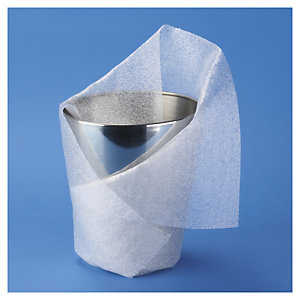
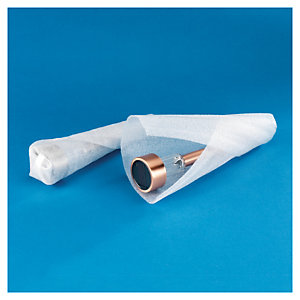
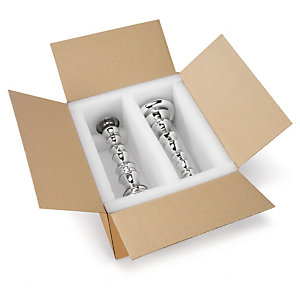
Foam packing sheets provide solid protection
Another protective foam material is foam packing boards – solid slabs of foam that have a very high cushioning effect. The sheets are not inelastic and do not mould to your products in the same way as foil. Instead, they are used to provide firm protection for heavier products such as furniture or to separate products from each other in a package. Like foam film, foam packing sheets are lightweight, easy to work with and suitable for reuse.
Which material is right for you?
Are you torn between bubble wrap and foam wrap? If so, we hope this guide has helped you. The materials have more similarities than differences – both materials are lightweight and pliable and provide effective protection for your products. But there are differences that can determine which material is best for your products.
Bubble wrap is generally the most popular choice. It’s a very versatile material, whether you need to package light or heavy products, there’s a version for you. However, foam film has the advantage of being thinner and therefore takes up less storage space. The smooth surface of foam also means that products with delicate surfaces are not at risk of damage. If you’re shipping electronics, we recommend choosing foam film or anti-static bubble wrap. If you want your products to sit securely or be separated in the package, rigid foam packing boards may be just what you need.
Want help choosing the right filling material?
RAJA are specialists in packaging and wrapping. On our website, you’ll find everything you need in packaging, from boxes and cartons to fillers and protectors, and more. Feel free to contact us to speak with our packaging specialists who, based on your products and needs, will offer free advice on which packaging solutions are best suited to your business’s unique needs and circumstances.
Stay in touch with us
- Subscribe to our newsletter for the latest packaging news and access to exclusive promotions
- Follow RAJA Sweden on Linkedin, Facebook and Instagram
- Check out our latest product catalogue – order a free copy or read the interactive catalogue online
Read the next blog post:
https://www.rajapack.se/blog-se/hur-atervinner-man-emballage/











